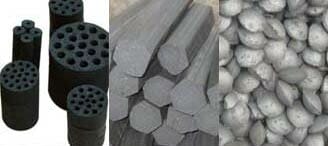Coal briquette is a kind of coal product that has been briquetted under certain pressure with certain shapes and physicochemical properties from a coal briquette machine or an extruder machine.
It usually uses coal dust to mix with binder and sulfur-fixing agent as well as some other additives to get the briquette.
Industrial-fired boilers and industrial kilns use coal briquette to significantly increase thermal efficiency and reduce emissions of coal-fired pollutants compared to burning raw coal.
Coal briquetting with the cleaning process and the clean product is suitable for global development and worth encouraging.

Technical requirements for a coal briquetting plant
Binder
Cheap and efficient coal briquette binder with waterproof, fast-consolidating features.
The main binders are waste liquid or waste residue from industrial and mining factories, which are processed and modified.
Use these types of binders to produce coal briquettes, the briquetting process can be free of drying system, producing water-proof briquettes, not afraid of rain, can be stacked out of the coal briquette factory, suitable for long-distance transportation, etc.

Additives
Coal dust can be blended with certain additives to form a coal briquette with catalytic, activating and sulfur-fixing functions, which accelerates the reaction speed of coal briquette in the combustion process, improves combustion conditions, and efficiently and rationally utilizes heat energy, greatly lower the harmful exhaust emissions.
The use of additives in coal briquette has opened up a vast world for the rational use of inferior coal and high-sulfur coal.
Briquetting
Satisfactory coal briquetting strength is obtained at briquetting pressures between 20 and 35 MPa. The total moisture is generally between 10% and 15%.
Briquette quality
Coal briquettes should have high heat and cold strength and good thermal stability.
When briquetting in a reasonable process and choose the right coal type, the technical indexes of coal briquette can meet the requirements of industrial boilers, furnaces, and gasifiers.
Process
The coal briquetting process is simple with a small investment. Coal dust is also lower in price. The coal dust only follows a two steps process of mixing and briquetting to obtain the finished coal briquette.

Coal briquettes applications
Coal briquettes are used primarily in two areas: industrial and civil.
Industrial coal briquette
Industrial coal briquette is mainly divided into gasified coal briquette and steam coal briquette according to its usage.
Gasification coal briquette
- Gas furnace gasification coal briquette
- Gasification coal briquette for coke briquetting
- Gasification coal briquette for coking
Steam coal briquette
- Industrial boiler steam coal briquette
- Steam locomotive steam coal briquette
- Industrial furnace steam coal briquette
Civil coal briquette is mainly divided into honeycomb coal briquette and coal ball briquette according to the appearance and shape of coal. These briquettes are usually used for BBQ, heating, cooking, fireplace, etc.
Specific industrial usage of coal briquette
Lime carbonized coal briquette
The coal briquetting plant using slaked lime as a binder is still widely used in small and medium-sized fertilizer plants.
Lime carbonized coal briquette uses coal briquette to decompose CO2 at high temperatures in a gasifier and use that as a raw material for carbonic acid producing. Its void ratio is 10 times higher than that of raw coal, so it has high chemical activity, and the binder source is wide and with low price.
However, due to the poor adhesion of lime, the thermal and thermal strength of coal briquette is not enough. It can only be applied to some of the furnaces. The amount of lime added is as high as 20% ~ 30%, and the coal briquette has low fixed carbon content.
Clean water coal rob
The clean water coal rob is made by raw coal which follows a process of crushing, mixing (with water), and extrude from the briquette extruder to get the coal briquette.
This kind of coal briquette needs suitable anthracite for production, can be directly used in the furnace, the temperature is equivalent to anthracite. The disadvantage is that it is not waterproof, and can only be briquetted beside the furnace. The briquette application is subject to greater restrictions.

Coal briquettes for carbonization
The main usage of this briquette is to produce coke briquette in the carbonization furnace, including coal briquette for coke briquette making and coal briquette for gasification.
Super waterproof coal briquette.
The super waterproof coal briquette can help improve the problems of coal briquette in long-distance transport and long-term wet storage.
Steam coal briquette
Steam coal briquette is used as a fuel (including industrial steam coal briquette and civil used coal briquette), mainly referring to industrial steam coal briquette.
Industrial steam coal briquette is mainly used as fuel for industrial boilers, industrial furnaces, locomotives, etc. The coal briquette is produced by adding a certain amount of biomass to the fuel which is also called as a bio-coal briquette.
The bio-coal briquette is briquetting the 70% to 85% coal by weight and 15% to 30% biomass on a high pressure. Biomass can be referred to crop straw and biomass industrial waste such as firewood, rice husks, bark, wood chips, bagasse, etc.
Together briquetting coal with biomass not only makes full use of energy resources but also reduces air pollution.

Future of coal briquetting
The future development of coal briquetting should be efficient, clean burning, and simpler production processes.
Develop high-sulfur rate industrial coal briquette on coal gasification. Develop industrial coal briquette that can use coal slime and biomass to improve resource utilization. Developing cheaper industrial coal briquette based on local conditions, and higher quality, more energy-efficient coal briquettes are the way forward.
